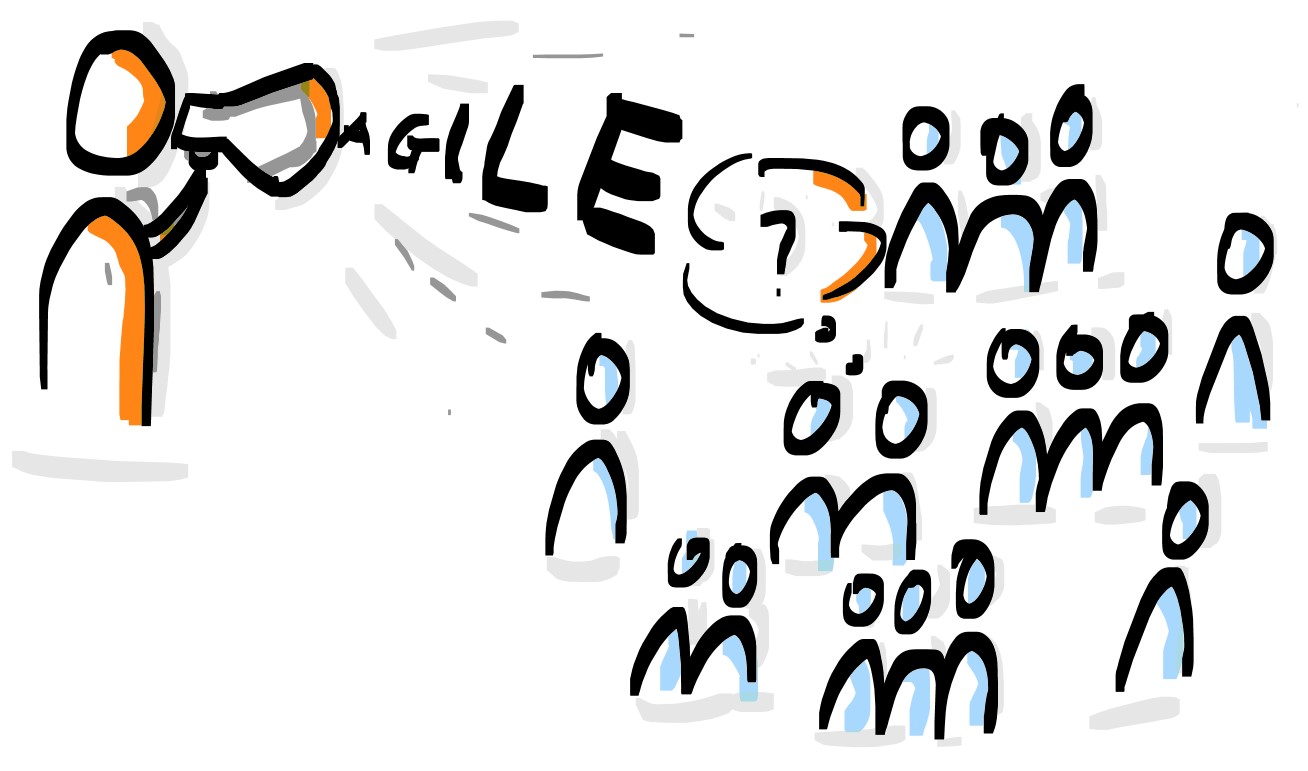Whoever wants (or needs) to start working agile usually has a lot of questions. Some very good and comprehensible examples of them I am occasionally asked. For example, these:
What do you see as the most common reasons why Agile fails?

Agile was invented to allow mistakes – within a secured environment.
Agile considers mistakes as something we can learn from. And learning is: GOOD! When agile change projects fail, it is often because this was not understood
And that is – viewed from the outside – a little funny. Because viewed in this way, agile MUST fail. Again and again!
Whether teams or even entire companies actually develop Agile
… therefore strongly depends on their level of awareness and maturity. If they are still entrenched in the machine, process, “complicated” world that believes, for example, in solution and performance through efficiency or the expansion of individual performance, etc., people will tend to introduce Agility according to this worldview.
That is: more as an “efficient” process. To a certain extent, this is even possible. After all, Agile routines even have a lot of process-ness to them.

People as experts of their own work
… however, are generally very intelligent. And this is especially true for social processes and organizational structures. So people quickly notice whether it is about an actual and significant change in collaboration or whether they are merely given a new, this time ” Agile marching orders”, which should not change anything in the fundamental structures (of power and decision-making), according to the motto: “From tomorrow 100% Agile!”
At least many motivated and interested in good in-kind performance
… members of an organization will feel fooled – and often rightly so. In this case, it happens to be what should obviously be avoided: teams are then often preoccupied with themselves for a longer period of time and entangled in unpleasant conflicts.
This distracts them from the important question: How do we become more successful again? How do we secure our business in the long term? Meanwhile, the customer is looking around for another supplier.
This all indicates, of course
…at one of the most important points why agile change processes often fail:
Leaders fail to create the framework conditions that agile working requires
There are many reasons for this. For example, it seems as if managers do not engage or engage only superficially with Agile as an organizational form, which they have just introduced there.
The question of how they would have to adapt in their leadership behavior and in their management role often does not seem to be of interest to them. So a certain lack of interest or ostentatious ignorance is often evident.

Another reason is
… of course, mindless power play and clinging to established power structures. And with all the power games, one can also suspect a pronounced self-uncertainty and lack of (self-) confidence. Or simply a giant fear of discovery, loss of control, existence and significance.
This is particularly bitter.
Because actually we need a strong, self-confident management anywhere, but especially in self-organized agile organizations. But just no controlling, distrusting micro-management trimmed for efficiency. And certainly no egocentric, selfish, power- or status-driven one.
What is needed is a visionary, trusting management committed to the cause and the people (and thus the value creation) and serving, which ensures that the experts can do a good job in terms of content. In the sense of the customer.
By the way, all this also applies in reverse to the team members, who often have a hard time with the new responsibility on their part.
My impression is
… that simply too few people are still able to think, lead, work in this way.
And that could remain that way even longer. Because we are all socialized in another, co-dependent way and we can’ t see that this will change quickly.
And so we lack the appropriate training, the convicted attitude, and also the (self-)confidence that it takes to work in a more self-organized, Agile way.
In addition, there is a very high level of social peer pressure
…especially, but by no means only (!) in management circles, which prevents the status-driven organizational culture from moving in the direction of Agile.
It would be nice if this was just unfortunate. However, it is more. Namely, very dangerous. Because so we remain in our stable processes.
If we consider the strong disruptive competitive pressure, which is huge and of which we may assume that it will rather increase than decrease, it can be a bit scary.
This is because agilely organized companies can continue to outstrip our hierarchically structured companies (with what I see as downright scandalous ease). And that even often, without the people concerned noticing or in any way understanding what is going on.
This is an enormous economic and sometimes even existential risk
Perhaps this must be the first mistake – the first crisis – of our agile change effort, from which we will learn. The experiment could be riskier and more expensive than some stakeholders would like. And maybe even ourselves?
What else comes to mind
- Appelo, Jurgen: How to Change the World
- Emiliani, Bob: The Triumph of Classical Management Over Lean Management. How Tradition Prevails and what to Do about it.
- Laloux, Frederic: Reinventing Organizations. A Guide to Creating Organizations. Inspired by the Next Stage of Human Consciousness.
- Logan, Dave: Tribal Leadership.
- Snowden, Dave: The Cynefin Framework, Youtube video from 11.07.2010
- Sutherland, Jeff: Scrum. The Art of Doing Twice the Work in Half the Time, New York, 2014.
 It would be nice if this was just unfortunate. However, it is more. Namely, very dangerous. Because so we remain in our stable processes.
It would be nice if this was just unfortunate. However, it is more. Namely, very dangerous. Because so we remain in our stable processes.